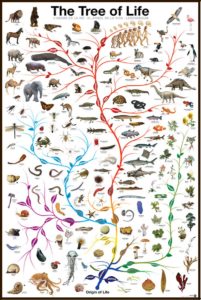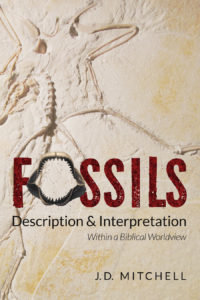It is my opinion that the number one “evidence” for organic macroevolution, as determined by the amount of promotion by secularists today, is the fossils in the rock record. These fossils are upheld as undeniable proof of evolution by school textbooks, TV shows, news reports, movies, and all the other regular societal methods for correspondence and entertainment. The verity of the famous Geologic Column relies on the existence of a rock record of many gradual fossil progressions throughout the world. In this article I will show that many evolutionary scientists know that this idea is really nothing but a myth.
It is a fact that fossils are used to promote evolution because there is no other better evidence, as seen in this quote: “Naturalists must remember that the process of evolution is revealed only through fossil forms. A knowledge of paleontology is, therefore a prerequisite; only paleontology can provide them with the evidence and reveal its course or mechanisms.” [Grasse, Pierre-P, Evolution of Living Organisms, (New York: Academic Press, 1977), p. 4.]
But then, consider this quote: “Fossils are never found with labels or certificates of authenticity. You can never know that the fossil bone you might dig up in Africa belonged to your direct ancestor, or anyone else’s. The attribution of ancestry does not come from the fossil; it can only come from us. Fossils are mute: their silence gives us unlimited license to tell their stories for them, which usually take the form of chains of ancestry and descent. Such tales are sustained more in our own minds than in reality and are informed and conditioned by our own prejudices, which tell us not what really happened, but what we think ought to have happened.” [Gee, Henry, In Search of Deep Time: Beyond the Fossil Record to a New History of Life, (The Free Press, New York, 1999), p. 2.]
But, aren’t there obvious transitional fossil pathways in the rocks?
“In the years after Darwin, his advocates hoped to find predictable progressions. In general, these have not been found—yet the optimism has died hard, and some pure fantasy has crept into textbooks.” [Raup, David M., “Evolution and the Fossil Record,” Science, vol. 213, (July 17, 1981), p. 289.]
“The extreme rarity of transitional forms in the fossil record persists as the trade secret of paleontology. The evolutionary trees that adorn our textbooks have data only at the tips and nodes of their branches; the rest is inference, however reasonable, not the evidence of fossils.” [Gould, Stephen J., “Evolution’s Erratic Pace,” Natural History, vol. 86, (May 1977), p. 14.]
Notice in Figure 1 below a typical “Tree of Life.” As Gould has stated in the quote above, this is totally artificial and does not represent reality. In this example, (except for the phony, yet iconic, human evolutionary series), data is “only at the tips and the nodes of the branches.” In every circumstance the supposed macroevolutionary process exists only in the minds of evolutionists. These “Tree of Life” posters are only for general consumption these days because professional evolutionists know that they do not represent reality. They have mostly moved to another phony system called “cladistics,” which looks scientific only to the gullible, and is based on the study of homologies. Click here for my explanation of cladistics in another article on this website.
Figure 1
What is it that is really seen in the fossil record? The answer lies in quotes A. through D. that follow:
A. “Species do indeed have a capacity to undergo minor modifications in their physical and other characteristics, but this is limited, and with a longer perspective it is reflected in an oscillation about a mean: to a paleontologist looking at the fossil record this shows up as stasis.” [Lewin, Roger, “Evolutionary Theory under Fire,” Science, vol. 210, (November 21, 1984), p. 884.)
B. “The history of most fossil species includes two features particularly inconsistent with gradualism.
- Stasis. Most species exhibit no directional change during their tenure on earth. They appear looking much the same as when they disappear; morphological change is usually limited and directionless.
- Sudden appearance. In any local area, a species does not arise gradually by the steady transformation of its ancestors; it appears all at once and ‘fully formed.’” [Gould, “Evolution’s Erratic Pace.” Natural History, vol. 86 (May 1977). P. 84.]
C. “The known fossil record fails to document a single example of phyletic evolution accomplishing a major morphological transition and hence offers no evidence that the gradualistic model can be valid.” [Stanley, Steven M., Macroevolution: Pattern and Process, (New York: Academic Press, 1977), p. 4.]
D. “It is, indeed, a very curious state of affairs, I think, that paleontologists have been insisting that their record is consistent with slow, steady, gradual evolution when I think that privately they’ve known for over a hundred years that such is not the case.” [Eldridge, Niles, “Did Darwin Get It Wrong?” Nova (November 1, 1981), p. 6.]
So, these evolutionist quotes dispute the whole concept of Darwin’s gradual, step-by-step macroevolutionary change in the fossil record. Darwin could not find it in 1859, but assumed it would be eventually be found. After over 160 years of fervent searching, since Darwin’s book was published, there is no indication it will ever be found. The only evolution that has been found is microevolution (variation within created kinds). But the evolutionary paradigm lives on, and now we are presented with cladistics, punctuated equilibrium, and hopeful monsters! Each of these ideas is based on a total lack of evidence. After 35 years of personal searching, I am still looking for the first bona fide example of transition from one kind of life to another kind in the fossils.
I have previously written about homology here. Do all scientists accept cladistics and homology as the new proof for macroevolutionary change over deep time? Not exactly, as seen in this quote: “Any set of objects, whether or not they originated in an evolutionary process, can be classified hierarchically. Chairs, for instance, are independently created; they are not generated by an evolutionary process: but any given list of chairs could be classified hierarchically, perhaps by dividing them first according to their color, by date of manufacture, and so on. The fact that life can be classified hierarchically is not, in itself, an argument for evolution.” [Ridley, Mark, The Problems of Evolution, (New York: Oxford University Press, 1985), p 8.]
Today, most secular paleontologists understand that the idea of gradual macroevolutionary transition is just not seen anywhere in the fossils in the rock record. There is no true evidence in the fossils of any “Tree of Life” or “molecules to man” macroevolutionary change. The concept of cladistics is an exercise in futility available for those who are so invested in a paradigm that they cannot extricate themselves. For these people, creationism, or even intelligent design, cannot be accepted no matter the evidence. So then, what should we Christians believe regarding this matter? What is it that is really seen in the fossils?
The answer is that we see what the evolutionists said about stasis, abrupt appearance, and transitional fossils; and that can best be explained by the global Flood at the time of Noah. We also see that the big picture is that life was created and engineered in the beginning by the Creator God, as described in the Bible. I think that the following chart is a good way to represent the true historical and morphological reality. This is not a “Tree of Life” but a “Forest of Life.”
That is what I think. What do you think?
J.D. Mitchell
For more on fossils get this book:





